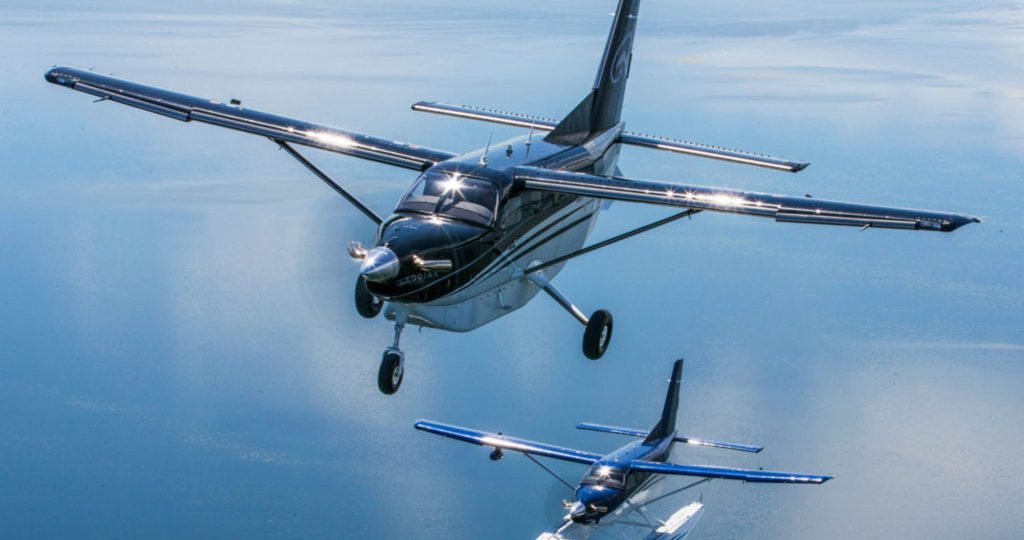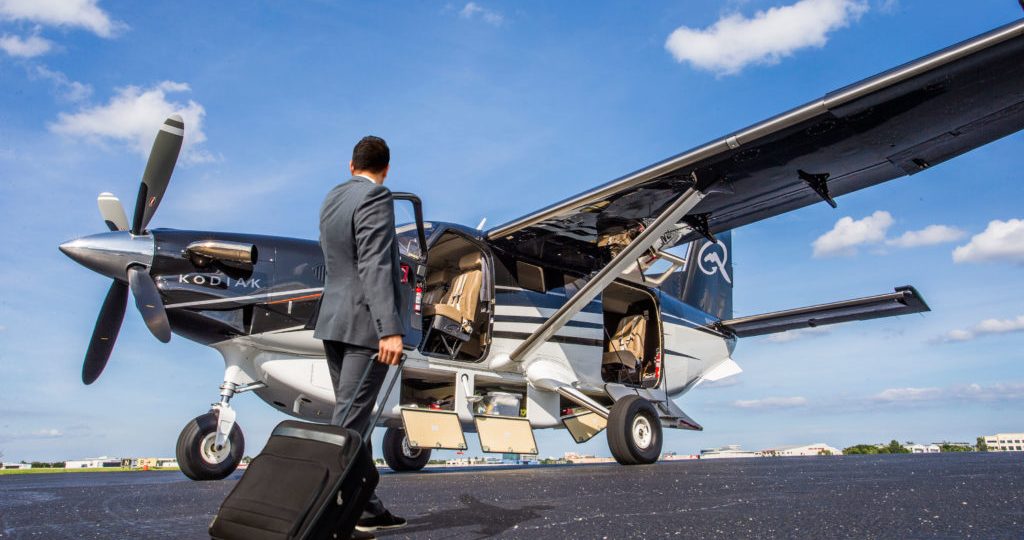Luxury meets adventure in the Quest Kodiak

The Quest Kodiak is a difficult plane to describe because it’s so many things at once. If you are looking for a flying Swiss Army Knife that can carry pretty much do anything and everything you can think of and get you safely in and out of short rough fields in hard to reach places, this is your bird.
The Kodiak sits tall on the ramp. The feel is more airliner than little general aviation plane. The preflight inspection is pretty straightforward and unlike most other seaplanes, this one rarely involves pumping water out of the floats. This is because the Kodiak was designed with a clean sheet for water operations and because the Aerocet floats are made of carbon fibre and don’t leak at all. Kodiaks are corrosion-proofed, so saltwater operations, the bane of seaplanes, aren’t to be feared anymore.
Quest began designing this plane to bridge the gap between jets and helicopters. Jets can fly far and fast and helicopters can land anywhere, but are complex by nature and require intensive maintenance. They are slower too and usually can’t carry much. The solution is Quest’s Kodiak. There have been other seaplanes before and some very capable ones at that, but they either weren’t fast enough, couldn’t carry heavy loads, or were too big and didn’t have sufficient range. They often weren’t very comfortable or quiet enough and were limited by other constraints. The Kodiak doesn’t do everything perfectly but it is the perfect blend of compromises that designers always grapple with.
The Kodiak’s wingspan is designed with most jungle strip’s 50-foot widths in mind. It needs less than 1,000 feet of runway at max weight, because 1,000 feet is often the standard for unimproved strips in the wilderness. The Cessna Caravan is a great plane too, but it needs a wider strip. The Pilatus Porter isn’t as big or comfortable and piston-powered seaplanes aren’t as reliable. The big Pratt & Whitney PT6A-34 hanging upfront is about as reliable an engine as you’ll see. It was designed to keep running no matter what and requires as little maintenance as possible. It also consumes very little jet fuel, at about 45 gallons an hour at cruise. Unlike Avgas, jet fuel is easily available throughout the world and is also considerably cheaper than Avgas and safer to transport and store.
The Kodiak was designed with safety in mind and apart from a seriously overbuilt landing gear its wing design is actually patented. Its Discontinued Leading Edge wing is built to provide lift across most flight regimes and can sustain flight when most other wings would call it quits and stall. Even in a spin, pilots can maintain rudder control to safely exit the spin. It’s built to Part 23-55 standards, which are much stricter than former regulations. For instance, the seats are built to withstand 26G impacts vs 9Gs on older planes. 26G is far more realistic should the unthinkable happen. Fire protection is one more aspect Quest tackled and the Kodiak is built with this requirement in mind. The whole airframe rather than only the passenger area is built to newer and more stringent flammability standards.
The avionics are also installed with safety in mind. The Garmin G1000 Flightdeck is simply superb at dispensing situational awareness and the GFC700 three-axis autopilot greatly reduces workload and allows pilots to keep their eyes outside the cockpit where they belong. The autopilot has an emergency levelling switch if the pilot gets disoriented. There are two large PFD displays and one MFD. Each screen gets its information from its own ADHRS and pitot tube for extra redundancy. The very capable weather radar is particularly easy to operate and interpret. Coupled with a WX-500 Stormscope and integrated into the G1000 it give pilots a comprehensive view of thunderstorm activity in flight.
Most bushplanes are great at operating in the wilderness, but Kodiaks can come and go from backwoods to busy airports without ruffling feathers and upsetting controllers concerned about precise navigation and expediting jet departures and arrivals. The Jeppesen-enabled chartview option is particularly good at giving pilots amazing situational awareness. The plane’s position is clearly marked on the Multi Function Displays and makes approaches as easy as 1-2-3. The system greatly increases safety when taxiing in large and complex airports and is a great tool to avoid dangerous runway incursions.
The big question is how does it feel to fly in the back and the answer is pretty amazing. The ride is vibration-free and noticeably quiet. It’s not quite as quiet as a jet, but quiet enough not to require headsets thanks to inflatable door seals. The interior is either efficient business-like or corporate jet-like if you choose the Summit Interior option from the three interior options available. The Tundra is perfect for heavy use operations such as regional hops and heavy-duty work. The seats can be removed in about 30 seconds and all eight seats have headphone jacks. It’s functional yet more than comfortable. The next step up is the Timberline option. It’s a good option between the functionality of the Tundra and the Summit. It has plush carpeting and better seating and more soundproofing. The Summit interior is similar to a luxurious jet interior and is a popular option as well.
The ride is comfortable and the Kodiak rides through light turbulence with nary a protest. The high wing ensures a pleasant sweeping view at a relatively fast 160 knots and a miserly 45-gallon per hour fuel consumption. Some quick numbers: maximum ramp weight is 7,305lbs and useful load is 3,505lbs. Fuel capacity is 320 gallons. Stall speed is a low 60 knots. At max weight, the takeoff roll is 934ft and the ground roll is 765ft. The Kodiak is certified to 25,000ft. Maximum cruise speed is 174 knots at 12,00ft. Maximum range is 1,132 nautical miles at 135 knots. Maximum endurance is almost 10 hours in the air. The cabin is almost 16 ft long and 4 and half feet wide. There is an optional TKS anti-icing System good for about 2.5 hours in icing conditions.
Kodiak is fun to fly
Starting the engine is the standard Pratt & Whitney starting procedure. Taxiing a big and tall seaplane on a windy day demands some attention and a little finesse, but the Kodiak is remarkably easy to taxi in challenging conditions. Once cleared for takeoff and aligned with the runway, I advanced the throttle and the plane just flew itself off the West Palm Beach runway in less than 600 feet. Climb was strong and we levelled off at 2,000ft in about 80 seconds. We headed towards Lake Okeechobee to practice water operations. Mark Brown, Quest’s Chief Pilot took the first landing and it looked easy enough. We transferred control of the plane and I set up for takeoff. I held the yoke back and the plane quickly got on the step as soon as I eased back on the yoke. I rotated soon after and the Kodiak lifted off without any drama. It was eerily smooth and quiet considering we had a good one to two foot chop. I think the carbon floats are noticeably better than regular aluminium floats. They are also substantially lighter.
Who needs a Kodiak or a Kodiak on floats? This is the question I kept asking myself. In Botswana, the Ministry of the Environment, Wildlife and Tourism uses the aircraft with Intelligence, Surveillance and Reconnaissance equipment to survey wildlife and prevent poachers from endangering local species. A skydiving club and parachuting school in Brazil uses one to launch skydivers from 12,000ft out of a dirt strip. A luxury resort in the Inland Sea of Japan ferries guests from the airport to the resort in as little as 15 minutes. A trip that used to take an hour and a half by road is now made easy and stress-free with a Kodiak seaplane. Mission Aviation Fellowship affiliates in Ecuador used the Kodiak for disaster relief and to evacuate wounded after an earthquake with a magnitude of 7.8. The Kodiak was able to operate out of dirt strips in some of the most remote areas of the country.
“The adventure is back and it’s spelled Kodiak.”
The answer is anyone who needs to operate out of challenging environments but doesn’t want to compromise on safety and comfort. It’s the perfect bird for getting principals and guests to island resorts with either limited runways or no runway at all. It’s perfect for mining or logging operations, for ferrying personnel to oil fields, for corporate titans to reach their islands, mountain chalets, yachts or fishing and hunting lodges. The Kodiak can be defined by its incredible ability to reach across a wide range of categories and capabilities but one simple mantra-like sentence comes back after all is said and done: it’s fun! The Kodiak bridges bygone eras and times still in our future. It reminds me of Hemingway and lazy mornings fishing off a boat in the Florida Keys in pre-Castro Cuban azure clear waters. It makes me think of expeditions in jungles and deserts with pith helmets and harsh conditions by people driven to discover new frontiers. It reminds me of futuristic space-age technologies and safety enhancements we could only dream of 20 years ago.












